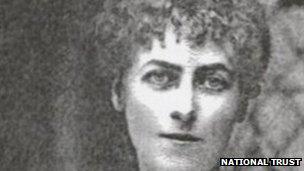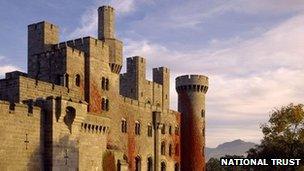Penrhyn Castle Alice Douglas-Pennant 'love story' uncovered
- Published

The writing etched on to the glass pane was thought for many years to be in Latin
Staff at a castle believe they may have shed new light on a decades old mystery and uncovered an aristocratic Victorian love story.
For several generations workers at the 19th Century neo-Norman Penrhyn Castle in Gwynedd have been aware of writing etched onto the glass pane of a window in one of the towers.
It was long believed the graffiti was a confused jumble of Latin words.
However, an Italian named Resi Tomat was taken on to the staff at the National Trust landmark and promptly came up with another explanation.
"Resi pointed out that the graffiti, 'essere amato amando', was actually in Italian, albeit with a few grammatical errors, and it actually reads, 'to be loved, whilst loving'," explains Clare Turgoose, house steward at the castle near Bangor.
The realisation encouraged Ms Turgoose and others at the castle to try to uncover more about the circumstances in which the graffiti came to be written.
In the late 1800s the castle, situated between Snowdonia and the Menai Strait, was inhabited by the second Lord Penrhyn, George Douglas-Pennant (1836-1907).
Formerly the Conservative MP for Caernarvonshire, Lord Penrhyn became prominent for his battle against trade unions at the Penrhyn slate quarry at Bethesda.

Lady Alice Douglas-Pennant was one of 15 children
This battle culminated in one of Britain's largest industrial disputes, The Great Penrhyn Strike of 1900-1903.
But, as Ms Turgoose discovered, it may not have been Lord Penrhyn's only conflict.
As she delved into the family's affairs she heard rumours of a falling out between Penrhyn - twice married with 15 children - and his second daughter, Lady Alice Douglas Pennant (born 1863).
'Gardener'
"We knew the nursery had once been Lady Alice's bedroom, and that she'd scratched her name on another window pane so it was fair to assume that the writing was probably hers," says Ms Turgoose.

The Douglas-Pennant family rebuilt the castle with money from sugar plantations and slate
"And when we began to dig a little we kept coming across the same story, or perhaps rumour might be more accurate, that as a young woman Lady Alice had fallen for one of the castle staff, possibly a gardener.
"Such a crush would not have gone down well with her father… and the story goes that he forced her to stay in the nursery to keep her away from her love."
The National Trust says it has discovered no documentary evidence as yet to corroborate the story and is undertaking further research into family diaries in a bid to do so.
And it may be that this story of a lovelorn young woman hidden away in a castle tower by her domineering father remains no more than a latter-day fairy tale.
True or otherwise, it had a sad ending. Lady Alice, who became an artist, died in London at the age of 76 in March 1939.
She was unmarried.